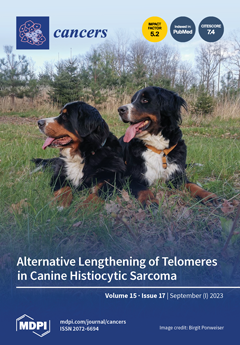Mutations in the estrogen receptor gene (
ESR1), its transcriptional regulators, and the mitogen-activated protein kinase (MAPK) pathway are enriched in patients with endocrine-resistant metastatic breast cancer (MBC). Here, we integrated whole genome sequencing with RNA sequencing data from the same samples
[...] Read more.
Mutations in the estrogen receptor gene (
ESR1), its transcriptional regulators, and the mitogen-activated protein kinase (MAPK) pathway are enriched in patients with endocrine-resistant metastatic breast cancer (MBC). Here, we integrated whole genome sequencing with RNA sequencing data from the same samples of 101 ER-positive/HER2-negative MBC patients who underwent a tumor biopsy prior to the start of a new line of treatment for MBC (CPCT-02 study, NCT01855477) to analyze the downstream effects of DNA alterations previously linked to endocrine resistance, thereby gaining a better understanding of the associated mechanisms. Hierarchical clustering was performed using expression of
ESR1 target genes. Genomic alterations at the DNA level, gene expression levels, and last administered therapy were compared between the identified clusters. Hierarchical clustering revealed two distinct clusters, one of which was characterized by increased expression of
ESR1 and its target genes. Samples in this cluster were significantly enriched for mutations in
ESR1 and amplifications in
FGFR1 and
TSPYL. Patients in the other cluster showed relatively lower expression levels of
ESR1 and its target genes, comparable to ER-negative samples, and more often received endocrine therapy as their last treatment before biopsy. Genes in the MAPK-pathway, including
NF1, and
ESR1 transcriptional regulators were evenly distributed. In conclusion, RNA sequencing identified a subgroup of patients with clear expression of
ESR1 and its downstream targets, probably still benefiting from ER-targeting agents. The lower ER expression in the other subgroup might be partially explained by ER activity still being blocked by recently administered endocrine treatment, indicating that biopsy timing relative to endocrine treatment needs to be considered when interpreting transcriptomic data.
Full article






